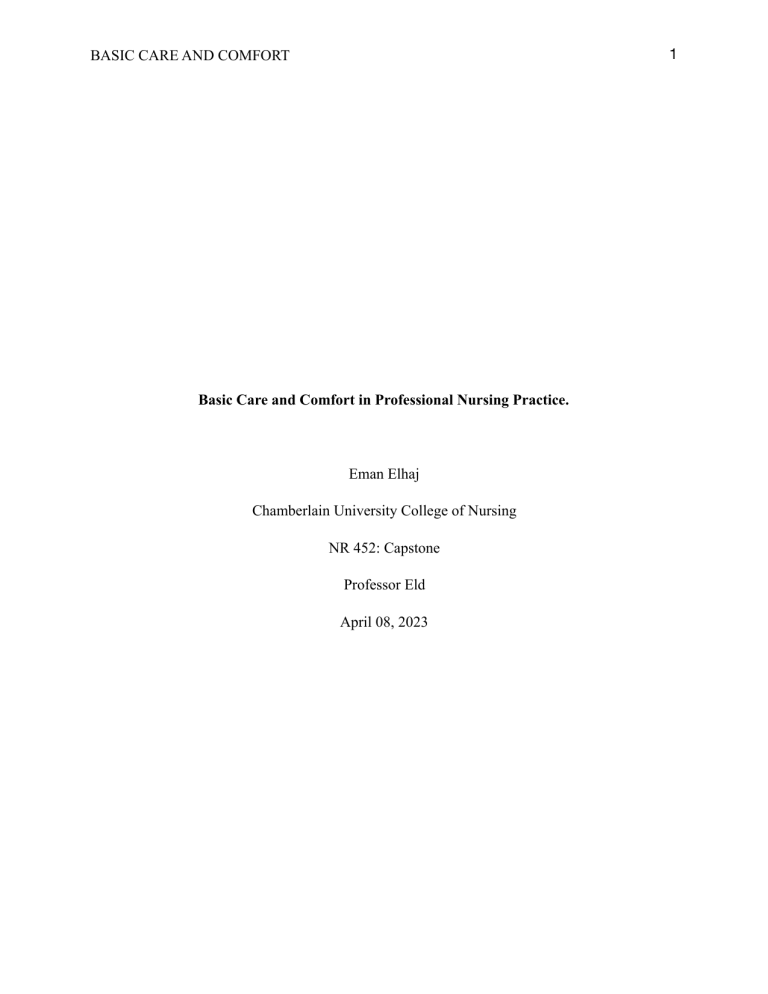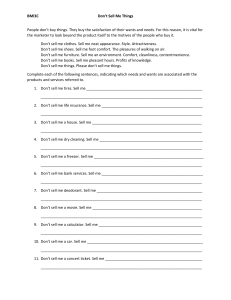
1 BASIC CARE AND COMFORT Basic Care and Comfort in Professional Nursing Practice. Eman Elhaj Chamberlain University College of Nursing NR 452: Capstone Professor Eld April 08, 2023 BASIC CARE AND COMFORT 2 The Relationship between Basic Care and Comfort and the Professional Practice There are many responsibilities that a nurse is required of while caring for patients to provide quality patient care, yet basic care and comfort is a topic that is highly important as it is the foundation and building block of quality and optimal patient care. The category of basic care and comfort makes up 6 through 12% of the NCLEX blueprint, which has been identified as this writer’s topic of choice. According to the National Council of State Boards of Nursing (NCSBN), “basic care and comfort are under the physiological integrity on the NCLEX-RN test plan” (National Council of state boards of nursing, 2021). The purpose of this paper is to discuss the importance of basic care and comfort in the nursing world and highlight the risks associated, discuss information regarding the topic, and the goal of increasing basic care and comfort across healthcare (Potter et al., 2017). Importance of Basic Care and Comfort to the Nursing Practice It is important to keep our patients comfortable during their care because if they are comfortable, they are at a higher chance of a quicker recovery and enduring optimal and healthier outcomes. Basic care and comfort include providing comfort and assistance in the performance of activities of daily living. Some examples of “basic care and comfort include assisting a patient that has physical impairment, basic hygiene care, maintaining patient sleep and rest pattern, providing patient comfort measures, and evaluating patient nutritional status” (National Council of state boards of nursing, 2021). Basic care and comfort are very important in the nursing profession because it is the foundation of quality care BASIC CARE AND COMFORT 3 and prevents additional health complications such as delayed healing, fall injuries, malnutrition, pressure ulcers, pneumonia, deep vein thrombosis, inability to perform daily living activities, and many more. A negative effect that could potentially risk the care of patients in the nursing profession’s basic care and comfort includes delay in healing. In the elderly population, basic care and comfort could be the reason for the major delays in recovery and acquiring additional complications due to their sensitive age group and already delayed healing process. Any additional health issues will increase delayed recovery. Healthcare Disparities, Inequalities, and Interventions There are specific populations that may be affected in receiving adequate patient care such as gender specific, age, race, ethnicity, socioeconomic status, uninsured patients, patients that do not speak the primary language of the community, physical disability, and patients at understaffed facilities. The Centers for Disease Control and Prevention (CDC) identifies health disparities as, “preventable differences in treatment of patient care and opportunities to achieve optimal health that are experienced by specific populations” (Centers for Disease Control and Prevention [CDC], 2016). Patients that are receiving care at understaffed facilities are at higher risk to acquire infection, prone to decreased quality care, postoperative complications, and a higher risk of falls. Some healthcare resources support nursing practice in this case such as the nursing code of ethics, which has placed rules and regulations against health disparities and inequalities. A solution for uninsured patient disparity includes the health coverage expansion across groups through “The Affordable Care Act”. The Healthy People 2030 mentions the goals of creating BASIC CARE AND COMFORT 4 social, physical, and positive environments that allow optimal potential for health and well-being for all individuals” (Healthy People 2023). Healthy People 2030 have a goal of increasing quality patient care across healthcare. Patients have the right to feel comfortable in the environment they are in, by their healthcare team, nurse, feel engaged with their treatment plan, connected spiritually and religiously, receive timely assistance, and feel engaged with their committed healthcare team. Evidence shows that patient comfort is directly related to the overall patient experience. Some evidence-based practice interventions for basic care and comfort include positioning of patients, offering relaxation and calming techniques that reduce anxiety, maintaining a stress-free environment, providing proper hygiene care and patient education related to their basic care and comfort, and the assurance of understanding of it. Legal & Ethical Considerations and Intervention Challenges Nurses have a responsibility of maintaining patient safety at all times. An ethical dilemma occurs when the facility is understaffed causing a high ratio of patients to nurse which puts the nurse in risk to provide safe patient care. The legal implication of negligence occurs as a side effect when nurses are given more patients than they can take care of putting the patient’s safety at risk. A strategy for preventing this ethical dilemma includes voicing this concern immediately to the supervising nurse. There are times when staff shortages are unexpected and as a patient advocate, it is the nurses’ responsibility to voice this dilemma to higher management to implement efforts to keep the ratio of nurses to patients within facility guidelines (American Nurses Association, 2015). A strategy for preventing this ethical dilemma includes delegating care to the appropriate staff members and prioritizing care based on patient needs and acuity. A strategy for preventing legal consequences related to this ethical dilemma includes getting leaders involved, acknowledging that there is an understaffing issue and addressing these concerns immediately. It is not always easy for a hospital to find help to relieve the nurse from a high ratio of patients, yet with the help of the whole unit working as a team, and advocating for the patient’s BASIC CARE AND COMFORT 5 safety, it has been successfully done in the past to eliminate the possibility of negligence (Potter et al., 2017). Participants and Interdisciplinary Approach The parties that will be involved in the interventions include the healthcare team that is directly involved in the patient’s care such as the physicians, respiratory therapists, physical and occupational therapists, dietitians, nurses, and other healthcare specialists. With nurses being at the direct bedside and care of the patient care, the nurses’ role is very important in implementing required interventions to maintain appropriate basic care and comfort for all patients. The role of physicians is to diagnose, treat and address health issues. The role of the respiratory therapist is to manage patients with complicated oxygenation and ventilation disorders. The role of the physical therapist is to improve the patient’s body movement and the occupational therapist’s role includes the patient being able to perform daily activities. The nutritionist’s role includes maintaining the optimal nutritional status of the patient. The nurses’ role includes direct patient care and maintaining nursing practice standards and developing quality procedures. Two members of a discipline outside of nursing are the social worker which advocates for patients on identified problems and the janitorial services which include maintaining a sterile and safe environment for patients (Potter et al., 2017). 6 BASIC CARE AND COMFORT Quality Improvement When basic care and comfort are provided in accurately, positive patient health outcomes are present such as reduced adverse events and injuries and prevention of unnecessary additional health complications. The benefit to the nurse includes confidence and clarity in their approach to their career and work life and positive work ethics which involves no liability at stake. A resource used to promote improved patient care would be the nursing scope and standards of practice guidelines that nurses must follow at all times to promote improved patient care. A resource used to increase professional nurse knowledge includes continuing education which is included through many facilities and companies to promote high-quality and safe patient care. Conclusion In conclusion, the importance of basic care and comfort in healthcare was discussed throughout the paper, the risks associated with not applying appropriate basic care measures, and the goal and recommendations of increasing basic care and comfort across healthcare. Resources such as the Centers for Disease Control and Prevention (CDC), The Affordable Care Act and The Healthy People 2030 support implementation of quality care of basic care and comfort. Addressing this topic is very important because basic care and comfort are the foundation of quality patient care which if neglected would lead to decreased quality patient care, the delayed patient healing process, and additional health complications such as delayed healing, fall injuries, malnutrition, pressure ulcers, pneumonia, deep vein thrombosis, inability to perform daily living activities, and many more. Together as the healthcare team and patient advocates, appropriate basic care and comfort must be maintained at all times to increase quality patient care across healthcare. 7 BASIC CARE AND COMFORT References American Nurse Association. (2015). Code of ethics for nurses. ANA. https:// www.nursingworld.org/practice-policy/nursing-excellence/ethics/code-of-ethics-for-nurses/. Abdelsamad, A., Mohammed, K. A. H., Ahmed, O., Elsayed, A., Ahmed, S., Abualama, H.,Kholood Ahmed, Avinash Bakhtiarpuri, Magedah Areqi, Nadir Abdelrahman, Abdelrahman, N. (2022). Role of non-pharmacological intervention for pain management in nursing home residents during COVID-19: A systematic review. The Journal of Pain, 23(5), 34. Retrieved from https://www.jpain.org/article/S1526-5900(22)00178-X/fulltext Centers for Disease Control and Prevention. (n.d.). Centers for Disease Control and Prevention. Retrieved April 09, 2023, from https://www.cdc.gov/ Iblasi, A. S., Aungsuroch, Y., Gunawan, J., Gede Juanamasta, I., & Carver, C. (2022). Repositioning practice of bedridden patients: an evolutionary concept analysis. SAGE Open Nursing, 8, 23779608221106443. Retrieved from https://journals.sagepub.com/doi/pdf/ 10.1177/23779608221106443 National council of State Board of Nursing. (2023). NCLEX- RN test plan. Retrieved from https://www.ncsbn.org/public-files/2023_RN_Test%20Plan_English_FINAL.pdf Potter, P. A., Perry, A. G., Hall, A., & Stockert, P. A. (2017). Fundamentals of Nursing (9th ed.). St. Louis Mosby Elsevier. Social Determinants of Health. Social Determinants of Health - Healthy People 2030. (n.d.). Retrieved April 08, 2023, from https://health.gov/healthypeople/priority-areas/socialdeterminants-health
